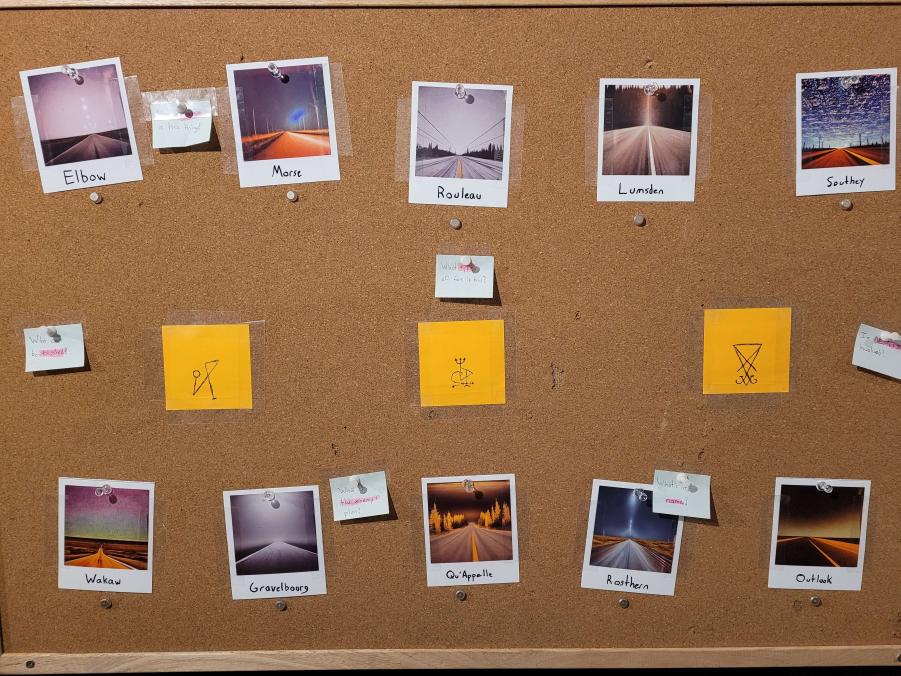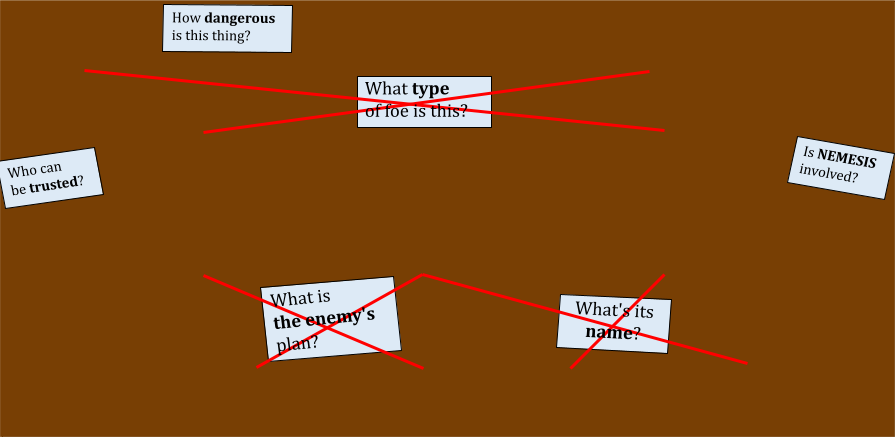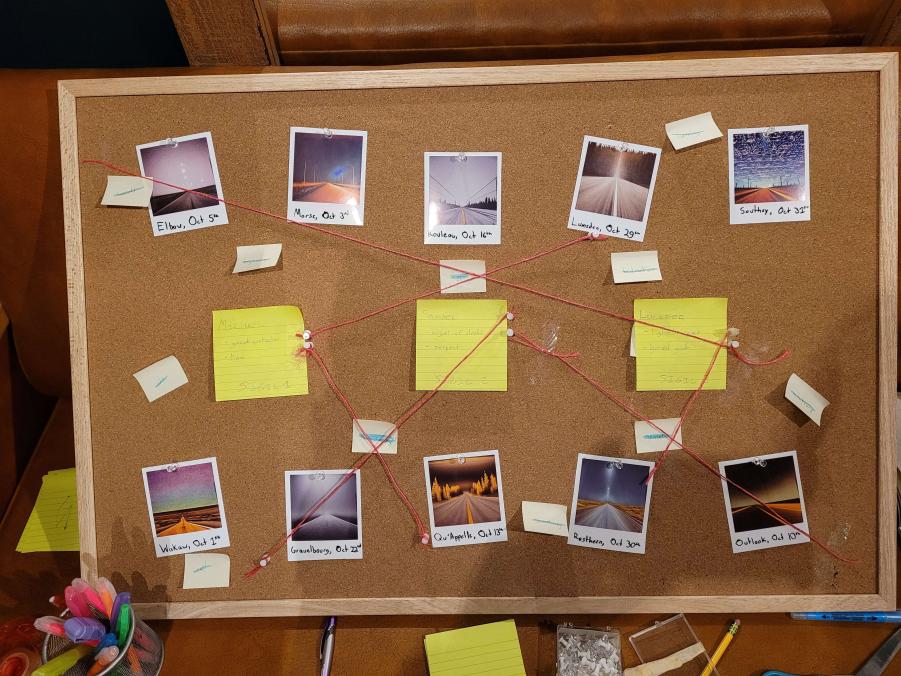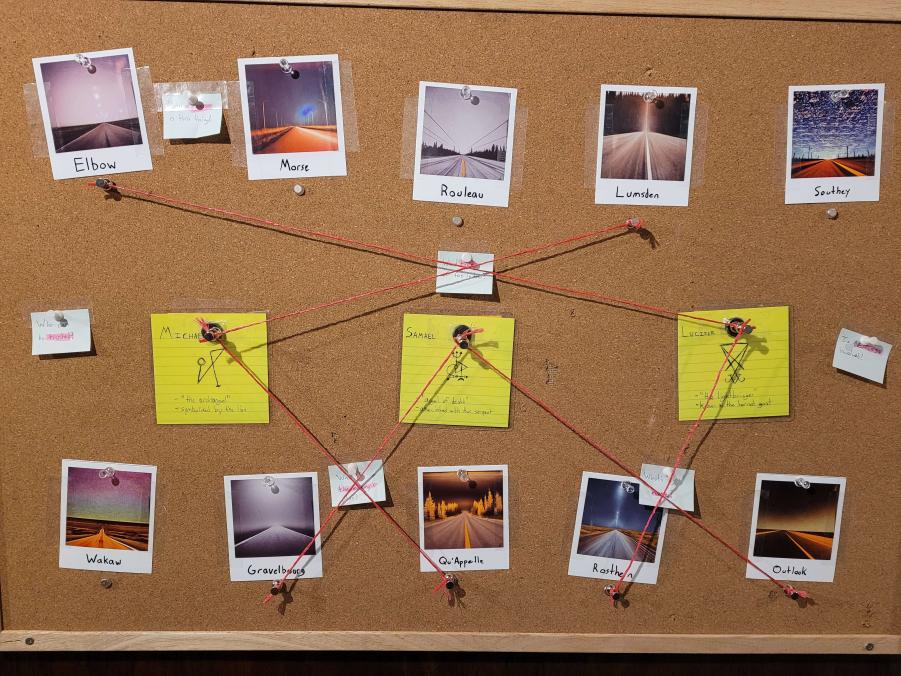Designing a Keystone Puzzle: Spellbound’s Conspiracy Board
Contents
- Introduction
- The Puzzle
- Requirements
- Solution
- Content
- Prototyping
- Iteration and Compromises
- Final Thoughts
Introduction
When designing my most recent escape room, Spellbound, I decided very early on that I wanted the highlight of the room to be a puzzle involving a conspiracy board. You know the type:

Charlie from It’s Always Sunny In Philadelphia, pointing to a conspiracy board with an intense look on his face
Some context: The theme of the room was heavily inspired by the TV show Supernatural. The players are introduced to the room under the premise that a hunter has gone missing, and they’re investigating his home in northern Saskatchewan to find out what has happened to him. As they progress, the players learn that the man they’re investigating was in fact a monster hunter.
Roughly 60% of the way through the room is when the big reveal happens. It’s the single most important moment in the narrative, so the gameplay needed to match that importance: it’s the culmination of the entire first phase of the room.

A whiteboard showing my initial blocked out flowchart. The critical bottleneck in the center is labeled “bulletin”, referring to this puzzle.
The Puzzle
Before I go into too much detail and spoil the puzzle, I invite you to spend a couple minutes working it out yourself, if you’d like. It’s admittedly a bit clunky to do with only photos, as it was designed as a pretty tactile puzzle, but I would be remiss not to give someone the opportunity before spoiling it in great detail.
Here are the various components of the puzzle:

The bulletin board

The clues

The angels
Finally, there are 6 red strings, to run between the items on the board.
Your goal is to identify the name of the entity behind everything, and what you’re expected to do with that name. Good luck!
Requirements
Now, I’ve seen conspiracy board puzzles in escape rooms before, but honestly none have really captured the feeling I wanted. Most such puzzles will show the players a completed board, and ask them to find something hidden in it. That’s perfectly fine, of course, but what I really wanted to create was the opportunity for the players to put everything together and make the connections by themselves. I want them to run the red strings from point to point and come to the same conclusion the character did!
So I boiled the puzzle down to its fundamental requirements:
- Content requirements
- The players themselves need to add information to the board, and run strings between correlated items. The method they do this needs to somehow be unambiguous - a successful solve will always result with the information and connections in the exact same place.
- As the puzzle is at the end of three independent streams of other puzzles, it needs to require at least three distinct components, rewarded at the end of each stream.
- Solution requirements
- When the puzzle is solved, the connections between items on the board need to reveal the critical information to the players. In this case, that would be the identity of the antagonist, the fallen angel Samael.
- The name Samael needs to somehow “unlock” something in the room so that the players can then progress. This is difficult, because standard word-locks only have up to five letters, so they’re off the table.
Solution
Because this puzzle required a bespoke solution, rather than a simple combination lock, I decided to focus on that solution first. Fortunately, the other designer offered a great idea for how to make the connections reveal the answer to the players: have various keywords throughout the bulletin board. When all of the connections have been run, the strings will intersect over specific keywords. Great! As for what the keywords would actually say, I was able to kill two birds with one stone. I had planned to have a tele-typewriter puzzle in the same room - a puzzle where the players type a password on a typewriter keyboard, and it responds by typing a message automatically.
So here’s the solution: “Type the enemy’s name.” The intersections highlight the keywords “type”, “the enemy’s”, and “name.” The rest of the information on the board will point to Samael being the force behind everything. The players type “Samael” on the typewriter keyboard, and it will print out a message with the next puzzle on it, beginning phase 2 of the room.

An early mockup of the bulletin board at this stage in design
Content
Now that I knew the solution, it was time to figure out the contents of the puzzle, and the actual process of solving it. The other designer suggested that we focus on angels. Since this puzzle was at the end of three streams, each stream would give the players a sticky note with information on an angel, which they place on the bulletin board. The connections will be from the angels to the other items on the board.
But what should those other items be? I struggled with this one for a long while. The obvious choice would be something like newspaper clippings, but that would have required a whole lot of writing, and would be asking the players to read a whole lot of text. I have learned over the years that players hate reading. It needed to be something else.
One night, I was hanging out with some friends and we were sharing horror images. One of them shared a photograph of a darkened highway with unsettling lights in the background, and I knew exactly what I wanted. As mentioned, this room was set in Saskatchewan. If you’ve never had the pleasure of driving on a Sask highway, here you go:

Saskatchewan Highway 42
Even having lived here my whole life, it’s still a bit of a surreal experience. You can quite literally observe the curvature of the earth driving down these highways. Sask highways are the perfect venue for supernatural activity. We got ahold of 10 particularly strange-seeming illustrations of highways, and I printed them out as if they were Polaroid photos. I wrote names of Saskatchewan towns on them, alongside some random dates in October. I didn’t have a clue what these towns or dates were yet! I just knew there needed to be something written on these “Polaroids”, so I seeded it with data that I hoped I might be able to make use of later. (More on that in a bit.)
Once I had these, I had all the necessary components to put together my first complete prototype!

The puzzle’s first prototype, arranged as if it’s been solved.
Prototyping
Obviously, it’s looking pretty rough at this stage, but it’s a critical proof of concept. Notably, it blocked out the layout that would dictate the puzzle, with the central row of three angels, the two rows of five photographs, and keywords scattered on other sticky notes. It isn’t easy to see in the photo, but each angel has a sigil on it. These sigils each match a sigil on the bulletin board, so the players can know where to place each angel note.
Of course, it also highlighted a critical issue: We couldn’t give the players thumb tacks! Not only is it seriously unsafe, it would be way too freeform. In a video game, it’d be easy to have items snap into place, or similar, but in the real world we needed to achieve that practically. The whole concept of this puzzle only works if each item is in just the right place.
The natural solution, of course, was to use magnets. Embedding magnets into the board would make it easy to fix them in place, and eliminates the need to provide the players with anything pointy they could hurt themselves with. Fortunately, it’s easy to get ahold of magnets shaped like thumb tacks, so the feeling of manipulating strings tied to thumb tacks would remain intact. This led to the next prototype:

The next prototype, with big bulky magnets added and the dates scribbled out.
You may notice that in this iteration, I’ve scribbled out the dates on each photo. What’s up with that? Well, I still needed to actually provide the players with the means to work out what connects to where. This is where the extra details of the towns and dates on those photos ended up paying off. I decided to have three sets of associations - one which associates towns with dates, one which associates dates with unusual events, and finally one which associates those unusual events with the three angels. This meant that ultimately, the towns end up associating with the angels, and that’s the connection the players would make on the board.
Each of these had pretty straightforward ways to deliver the info to the players. I put together a typewritten note with a list of towns the character visited on specific dates. I filled out a calendar for the month of October, with notes about events on the relevant dates. The angel sticky notes each had a couple of identifying details about the angels on them, so the events corresponding to those angels would be about those specific details.

The calendar and the typewritten note.
The nice thing about this setup was that, in addition to having one sticky note for each of the three streams, I also had three distinct components that were necessary to solve the puzzle, making the progression even more clearly gatekept. One stream got an angel and the calendar, one stream got an angel and the note, and one stream got an angel and the strings.
With these made, the puzzle was now solvable, from the point where all components are collected, up until typing on the typewriter.
Iteration and Compromises
The puzzle being solvable, of course, isn’t the end. We spent several days testing this prototype on our staff - the people who would end up operating the room upon launch. If these guys ran into problems trying to solve it, we know for sure that something’s wrong. This is the stage where the biggest problems came up.
For starters, we soon realized that the strings weren’t strictly necessary to solve the puzzle, as the players could just imagine them. To ensure that that stream would still be required, I decided that the strings would always be earned from the same stream as the Samael note. That way, they can’t get the name to type until they’ve solved that stream, even if they solve the rest of this puzzle beforehand.
There was also some serious ambiguity in the original calendar. I don’t have any photos of it, but certain dates had events which could very reasonably be associated with two distinct angels, rather than being a clear fit for one. There were also certain dates which weren’t supposed to be associated with any angels, but had associations I had overlooked. The testing was invaluable to identify these concerns before launch.
Unfortunately, an even bigger problem came up. As I was working on the teletype, I made a mistake, and shorted the ground rail to the 24V rail of the typewriter. I had totally bricked it… and we had our first group booked to play the room the very next week. There was no way to get ahold of another electronic typewriter before launch. I had to totally scrap the teletype idea, which presented a serious issue: the entire solution of the conspiracy board puzzle depended on us having a typewriter!
Time being tight, I found a compromise. The typewriter’s keyboard was still mechanically functional; it was just dead electronically. The game master would be able to watch the typewriter on camera, and manually trigger an override once the players typed the correct name. Since we had a working sound system, I recorded myself reading out the information that would’ve been teletyped, as if I were the hunter recording a voice log. It was far from the ideal outcome, but it got us to the finish line in a pinch. (We would later eliminate this voice log some time after launch, thankfully, replacing it with a typewritten note more close to the original intention.)
In the meantime, the other designer was hard at work cleaning up the bulletin board itself. He did a great job - embedded magnets instead of taping them, made the proper magnetic strings, and got the board attached to the wall of the room. I also made new versions of the three angel notes, with the proper sigils drawn on them and with the notes laminated for protection. This resulted in the version of the puzzle we ultimately launched with:

The final iteration of the board, in its solved state.
Final Thoughts
This was the most complex puzzle I had ever designed for an escape room. Puzzles with this level of difficulty and complexity are hard to pull off in a medium where players have only a single hour of gameplay available to them. It was only because Spellbound was going to be our largest and most difficult room that I had any opportunity to try something like this.
I took a big risk with even the underlying concept. Normally, a keystone puzzle like this would focus on achieving its “wow factor” theatrically - fancy complicated tech, big set pieces, opening a door into a totally different looking set, etc. Instead, for this puzzle, I tried to create something where the “wow factor” was all in the gameplay itself. It was understated, with minimal tech - just the players and one really difficult puzzle.
Fortunately, in this instance, the gamble paid off. Many players rapidly identify it as their favourite puzzle in the room, and the most satisfying for them to solve. Despite the serious difficulty of designing a puzzle like this, I do really think it was worth it.
With that being said, I don’t anticipate making another puzzle like this for another room soon. As mentioned, the target difficulty was a major component in this puzzle’s success, but there’s another factor here too. The very risk I identified earlier, of forgoing something theatrically impressive for the sake of gameplay, ended up elevating it to players because of the novelty of it. Escape room enthusiasts crave variety!
It would be a mistake to come away from this believing that every room should have this kind of puzzle. In all honesty, it was such a delight to design that it’s hard to resist the temptation, but I know better. Instead, I think it’s a technique that can take the right kind of escape room to the next level, when applied well. I look forward to the next opportunity I have to make something like this.
Spellbound © 2022 Escape Club Entertainment, Ltd. All rights reserved. All materials used with permission.
Photo of Junction 42 © 2007 SriMesh. CC-BY-SA 3.0.
It’s Always Sunny In Philadelphia © FX Networks, LLC. All rights reserved.